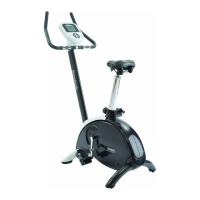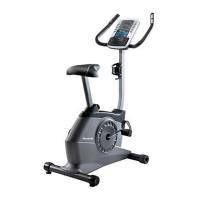3. Belt driven Bike
Important: A loose belt as well as an over-tightened belt will
cause damage to the belt and drive system.
Checking Belt Tension:
To check for a loose belt, sit on the saddle, place your feet
on the pedals, move the pedals until the crank arms are
horizontal. Next, push down the emergency brake handle and
hold it. Then, stand on the pedals and rock forward and
backward. There should be no more than 1/8th inch (2–3 mm)
of play in the belt. If there is too much play in the belt, this
indicates that the belt is too loose.
Correcting Belt Tension:
To correct a loose belt:
To adjust the belt, pull off the right
and the left maintenance covers (
A
).
Loosen the axle nut (
B
) on both ends of the flywheel axle two
full turns.
Loosen the Outer Adjustment Nut (
C
) facing the head of the
Allen bolt on each side of the flywheel. Then, turn both (right
and left sides) of the Inner Adjustment Nuts
(D)
on the inside
of the flywheel bracket 1/4 of a turn at a time
(upward on the
R side and downward on L side)
until the belt is properly
adjusted.
Make sure to turn both adjustment screws
exactly the same amount to avoid misalignment of the
flywheel.
Re-check the amount of play in the belt as described
at the beginning of this step. If necessary, readjust the belt.
Finally, retighten the two Outer Adjustment Nuts (C) and the
two axle nuts (B), and reattach the maintenance covers.
To avoid damage to the flywheel bearings, do not over
tighten the axle nuts (B).
Unusual noises or vibrations are
indications that the belt has been over tightened or that the
flywheel is at a wrong angle.

